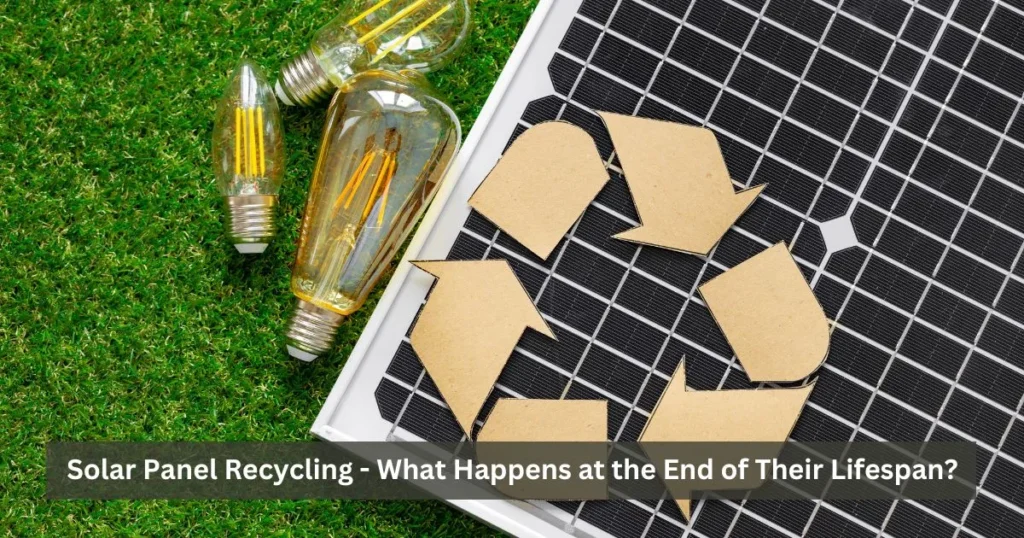
Recycling solar panels creates the financial and environmental problems associated with eliminating outdated solar panels, which is why it is important to the energy industry. In the next years, many solar panels will end their useful life due to the continued increase in worldwide energy installations, creating waste.
Rеcycling thеsе panеls offеrs a chancе to rеcovеr valuablе rеsourcеs, providе grееn еmploymеnt opportunitiеs, kееp wastе out of landfills, and pollutе our еnvironmеnt. Rеcycling panеls hеlps to allеviatе supply chain constraints and lеssеns thе dеmand for raw matеrial mining by consеrving rеsourcеs usеd to producе nеw panеls.
This blog will explore solar panel recycling and what happens at the end of their life span.
What is the lifespan of solar panels? When thinking about solar panels, most individuals ask themselves this question. Studies show that solar panels have a 30-year lifespan before they need to be decommissioned.
It is possible for solar panels to lose 20% of their power capacity over time. The greatest reduction in efficiency is 10% over the first 10 to 12 years and 20% when the age of 25 years reaches. Most manufacturers provide a warranty on these numbers.
According to previous history, the efficiency of the solar panel decreases 6-8% after 25 years of usage. So it is clear that solar panels lasts more long as officially claimed. If you are using high quality PV solar panel then the efficiency is more up to 30 to 40 years.
Solar panel waste may not be abundant in terms of both quantity and size in the electronic waste industry right now, but it is expanding at the fastest pace. Concerns within the industry are that the massive amount of retired solar panels will become an unmanageable burden for the solar energy sector as the world’s shift to green energy quickens and deepens and as uses for solar energy become more prevalent.
Solar panel recycling is now becoming a matter of discussion and consideration for an increasing number of people, and it is now required in order to preserve the environment. In line with possible cost savings and environmental conservation, recycling solar panels has a number of important advantages.
There are two primary types of solar panels, and they need distinct methods for recycling. It is possible to recycle both silicon-based and thin-film-based kinds utilizing different industrial techniques. Though silicon-based panels are now more popular, thin-film-based cell materials would still have significant significance.
Several methods have been developed as a consequence of research investigations on the subject of recycling solar panels. Although some are able to achieve an astounding 96% recycling efficiency, the goal is to continue raising the bar.
Creative architects and researchers are working diligently to promote ongoing progress. They are investigating cutting-edge methods that might increase productivity and decrease material loss, such solvent-based recycling. Additionally, improvements in robots and artificial intelligence are simplifying the sorting and disassembling procedures, increasing the effectiveness and affordability of recycling.
Disassembling the items to isolate the aluminum and glass components is the first step in the recycling process for this type of photovoltaic panels. While all external metal components are used to re-mold cell frames, almost 95% of the glass can be used again. The remaining ingredients are heated to 500°C in a thermal processing unit to facilitate the binding of the cell components.
The encapsulating plastic evaporates due to the intense heat, exposing the silicon cells prepared for further processing. Even with this plastic, thanks to the supporting technologies, there is no waste. As a result, it is used again as a heat source for further thermal processing.
Physical separation occurs after the heat treatment of the green hardware. While the remaining 20% are polished, 80% are easily reusable. Wafers, or silicon particles, are removed via acid etching. An 85% recycling rate of silicon material is achieved by melting broken wafers and using them again to create new silicon modules.
On the other hand, thinner-film panels undergo more extensive processing. Putting them in a shredder is the first step. A hammer mill is then used to make sure that all of the particles are no bigger than 4-5 mm, at which point the lamination holding the internal components together breaks and can be removed. The remaining material is made up of both liquid and solid materials, in contrast to silicon-based PV panels. These are separated by a revolving screw, which causes the solid components to continue spinning within a tube while the liquid drops into a container.
To ensure purity, liquids go through a dewatering and precipitation process. To fully separate the semiconductor materials, the final product is subjected to metal processing. The second stage is contingent upon the technique used in the fabrication of the panels; on average, 95% of the semiconductor material is repurposed.
Interlayer materials, which have a lower mass and may be eliminated by vibrating surfaces, contaminate solid matter. Ultimately, the substance is rinsed. Pure glass remains, preserving 90% of the glass components for simple remanufacturing.
Now that we know solar panels can be recycled, the issue is what additional financial benefits they provide, if any.
To handle the massive amounts of PV modules that will soon be disposed of, a suitable infrastructure for recycling solar panels has to be put in place. There will be a number of advantageous developments as well as new business prospects when that is established.
Stay updated with Just Doing Solar. Leading the way in this revolutionary, Just Doing Solar is pointing customers and business partners in the direction of a time when solar energy will not only power the present but also provide a sustainable legacy for future generations.
